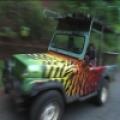The people in the book are real, two victims' names have been changed, and the narrative and dialog were masterfully reconstructed from interviews and memories of those who participated in the crises.
Hazelton Research Products, a division of Corning, Inc. was importing and selling lab animals. On October 4, 1989, the monkey house called Reston Primate Quarantine Unit located not far from Leesburg Pike, received a shipment of one hundred crab-eating monkeys (a type of macaque) from the Philippines, caught on the island of Mindanao. Two of the monkeys were dead in their shipping crates. By first of November, 29 of the monkey were dead, most of them in Room F. The heating and air system had failed so it was assumed the deaths had occurred from ambient conditions. Each night more macaques died. By November 16, a tentative diagnosis was given "simian hemorrhagic fever."
Thomas Geisbert, an intern at the Institute discovered under his electron microscope the dreaded Ebola virus. Dr. Jahrling tested the virus cultures from the macaques against three known blood serums:
- Musoke (test for Marburg virus)
- Boniface (test for Ebola Sudan)
- Mayinga (test for Ebola Zaire)
The virus cultures glowed brightly against the Mayinga blood serum indicating that the monkeys in the Reston house died of Ebola Zaire strain, the deadliest of all filoviruses (Ebola).
- ·
- Report
- ·
- October 16, 2014 3:16 pm
Having read the Hot Zone when it hit the bookstores (hardcover) I was well aware of Ebola when it was loose in Reston. it was an accident and was contained. Those who knew didn't freak. I believe that Ebola has gained strength is now more virulent than it was several decades ago. I am also aware of the conspiracy theories and any one of them could be the truth. However, Ebola is real and it is highly contagious when you come into contact with it. I think these conspiracy theories are giving the wrong impression to some people who believe that the Red Cross intentionally infected people with the virus and that it cannot be picked up by any other method.
Even if it was intentionally introduced into the population doesn't mean that the only way to contract it is through inocculation.










